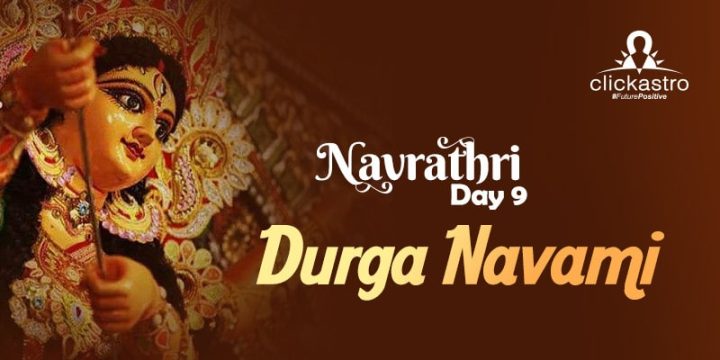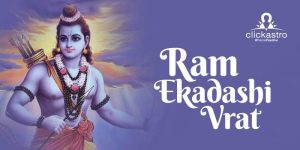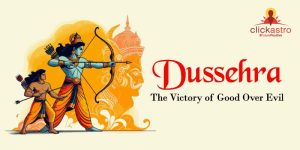Contents[hide]
Read about Navratri Day 8 – Durgashtami
Devi Siddhidatri
Devi Siddhidatri is believed to be the primary form of Goddess Shakti. The name Siddhidatri means giver of Siddhi or abilities. The 9-day Navratri festival culminates with the worship of Devi Siddhidatri. Lord Shiva in the form of Ardhanarishwara has Devi Siddhidatri forming his left half. She is believed to govern the planet Ketu and provides direction and energy to it. Devi Siddhidatri is seen seated on a lotus and she rides the lion. She is draped in red and has a golden complexion. She is depicted as having four hands. On one right hand, she holds a Gada and on the other right hand, she holds the chakra. On one left hand, she holds a lotus flower while on the other left hand she holds the shankh. Devi Siddhidatri bestows devotees with all types of siddhis. Apart from Earth, Devi Siddhidatri is worshipped by Devas, Gandharva, Asuras and other beings in the fourteen lokas. She rules the thoughts of devotees and inspires them to lead a disciplined life based on spiritual ethos. Additionally, she removes all worries and removes sufferings from the lives of the devotees. Devi Siddhidatri is also worshipped for her power to satisfy dreams and impart genuine understanding to devotees.Devi Siddhidatri mantra
In this increasingly chaotic world, regular chanting of mantras is a good way to find inner peace. Mantra is a phrase or a word addressed to a certain divine being to invoke their blessings in life. Repeating the mantra during meditation releases positive energy and boosts mental awareness in the person. The ‘man’ in mantra means mind and ‘tra’ means release. These days, chanting mantras is used as an alternative treatment method for certain medical conditions. The release of sound waves during the chanting helps in harmonising life. Chanting mantras has been followed by different religious groups for thousands of years as means to attain spiritual and psychological powers. Traditionally mantras have been seen as a way to gain blessings, make atonements and attain salvation. Mantras are chanted for the fulfilment of desires or objectives in life. They are also used to overcome uncertainties and dilemmas. Chanting mantras makes the soul of the person get in touch with cosmic energy that exists beyond time and space. A mantra when repeated constantly can activate dormant brain cells and change consciousness. It also releases stress and makes the person feel calm and relaxed. Chanting mantras can also improve your memory and self-awareness.The following are the Devi Siddhidatri mantras. Chanting them on Navratri day can get the devotee in touch with the divine being of Devi Siddhidatri and gain her eternal blessings. Om Devi Siddhidatri yai Namaha Om Hreem Shri Siddhidatri Durgaaye Namaha Siddha-Gandharva-Yakssa-Adyair-Asurair-Amarair-Api Sevyamaanaa Sadaa Bhuuyaat Siddhi-Daa Siddhidaayinii Ya Devi Sarvabhuteshu Maa Siddhidatri Rupena Samsthita Namastasyai Namastasyai Namastasyai Namo Namah
Devi Siddhidatri worship rituals
On the 9th day of Navratri, wake up early in the morning, take bath and wear clean clothes. Clean the puja room and place an idol or picture of Devi Siddhidatri on a pedestal. Then light a ghee lamp, incense sticks and dhoop. Do the Atman Puja for self-purification and apply tilak on your forehead. Then do the Kalash Puja. After this, offer fruits, flowers, neyvedh etc. to the Devi. Worship her as per rituals and perform aarti. Chant the Siddhidatri mantra while doing this. A unique feature of Devi Siddhidatri worship is the importance given to worshipping girl children. For this nine young girls below the age of ten are invited home. Apply tilak on their forehead and do Aarti while chanting the Siddhidatri mantra. Once the girls are done having a meal, they are presented with money and clothes and their blessings are sought. Performing these rituals will invoke the blessings of Devi Siddhidatri and get the devotee the results that he or she seeks. Peace and happiness will enter their lives as a result.Devi Siddhidatri story
In the beginning, the Universe was entirely void. Everything was still and everything was dark. Then a light blew. In Vedic tradition, it is referred to as the smile of Goddess Shakti. After bringing light into the Universe she gave form to the Trimurtis – Lord Brahma, Lord Vishnu and Lord Shiva. With them, Goddess Shakti entrusted the duties of creation, sustenance and destruction respectively. The lords Brahma, Vishnu and Shiva did penance. Pleased with their penance, Goddess Shakti took the form of Devi Siddhidatri and bestowed each of them with siddhi in the form of Devi Saraswati, Devi Lakshmi and Devi Parvati respectively. The devis were to help their lords in carrying out their tasks. The strength of the lords was in their devis and it was through them that the lords completed their tasks. But Lord Shiva continued with his penance. He wanted to achieve absolute perfection in himself. To fulfil this desire of Lord Shiva, Devi Siddhidatri went in and formed the left part of Lord Shiva. Thus Lord Shiva became Ardhanarishwara and achieved absolute perfection. Devi Siddhidatri then continued by filling the Universe with sources of Shakti like stars, planets, sun, solar system, devas, asuras, plants, animals, mountains, lakes and everything else that coexists. Because of her command, every being in all the 14 lokas worship Devi Siddhidatri. She is the creator of every particle in the universe and she is the one that bestows the devas and siddhas with their divine abilities.Devi Siddhidatri significance
Devi Siddhidatri is the giver of siddhis. There are 18 kinds of siddhis – 8 supernatural siddhis and 10 siddhis of perfection.The 8 supernatural siddhis or Ashtasiddhis are:
- Anima – the ability to shrink one’s body to the smallest scale.
- Mahima – the ability to grow one’s body to the largest size
- Garima – ability to increase body weight.
- Laghima – the ability to decrease body weight to practically nothing.
- Prapti – the ability to be at many places at a time.
- Prakambya – the ability to achieve everything through desire
- Ishitva – the ability to achieve supremacy over creation
- Vashitva – the ability to control the world around the person.
The 10 siddhis of perfection are:
- Anurmi-mattvam – the ability to transcend bodily urges like hunger, thirst etc.
- Dura-sravaṇa – the ability to hear things from far away
- Dura-darsanam – the ability to see things that are far away
- Manaḥ-javah – the ability to move wherever thought goes
- Kama-rupam – the ability to take any form
- Para-kaya pravesanam – the ability to enter another body
- Sva-chanda mrtyuh – the ability to control death
- Devanam saha krida anudarsanam – the ability to see gods and take part in their pastimes.
- Yatha sankalpa samsiddhi – the ability to turn determination into accomplishment
- Ajna apratihata gatih – the ability to have command over others.







